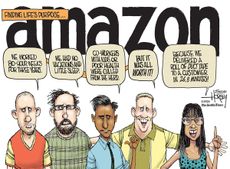Roku beat Apple to the Smart TV game
And, for once, Apple may not mind having someone else test the waters


Las Vegas is hosting the annual Consumer Electronics Show this week, promising an avalanche of news for gadget aficionados and tech enthusiasts. Among the early newsmakers is Roku, the maker of a popular puck-sized box that connects your TV to the internet. Roku is betting that there's a market for cutting out the set-top box entirely and putting the Roku magic directly inside your TV. It's not a bad bet.
Starting this fall, the Saratoga, Calif., company is putting out six models of its new Roku TV, ranging from 32 inches to 55 inches. The TVs are being built by two big Chinese manufacturers almost unknown in the U.S., TCL and Hisense. The Roku TV won't be the first internet-connected television set, but it's "the first Smart TV worth using," says Roberto Baldwin at Wired. Most of its would be "smart TV" competitors "are anything but," with terrible, clunky navigation screens and user-unfriendly viewing options.
What makes the Roku TV so much better? CNET offers this first look:
Subscribe to The Week
Escape your echo chamber. Get the facts behind the news, plus analysis from multiple perspectives.

Sign up for The Week's Free Newsletters
From our morning news briefing to a weekly Good News Newsletter, get the best of The Week delivered directly to your inbox.
From our morning news briefing to a weekly Good News Newsletter, get the best of The Week delivered directly to your inbox.
A dead-simple, user-friendly gadget that could redefine an entire category of consumer electronics — isn't that supposed to be Apple's game? From the iPod to the iPhone to the iPad, Apple's track record of turning old ideas into new markets is legendary. Apple is already a Roku competitor, with its Apple TV box going head-to-head against Roku's set-top bricks (and Google's Chromecast). It could have been first with the actual TV set, too. Probably.
"No one outside Cupertino knows if we'll ever see an Apple Television," says CNET's Matthew Moskovciak, though an actual Apple-branded TV set is one of the persistent rumors in the tech press — analysts now expect one to appear, maybe, in 2015 or 2016. The Roku TV should be "sort of like the mythical Apple TV HDTV," Wired's Baldwin says. "But, you know, real."
In this case, Apple may be happy to let Roku go first, even if it means losing bragging rights or market share. Roku already has a sizable following, having sold eight million of its set-top boxes, and if it can capture Apple's "it just works" ethos and prove that people want their TVs to stream the internet with Roku as a bridge, the smaller company is just creating a market for Apple to step into when it has something new to offer.
If, on the other hand, people don't want to tie their TV inexorably to one interface — there are legitimate reasons some people prefer component systems to all-in-one devices — or the Roku TV doesn't take off for any number of possible reasons, Apple can avoid a costly mistake.
Sign up for Today's Best Articles in your inbox
A free daily email with the biggest news stories of the day – and the best features from TheWeek.com
Roku isn't waiting around to see, and CNET's Moskovciak is bullish on Roku TV's chances:
The idea isn't all that different than the Smart TV features included by most TV manufacturers, except that it's Roku's excellent software, which means Roku TVs will have access to over 1,000 channels, cross-platform search for movies and TV shows, and a clean, simple user interface. Roku's best-in-class streaming software is one of the main reasons the company's boxes have earned CNET's Editors' Choice award over tough competitors like the Apple TV and Google Chromecast. [CNET]
Create an account with the same email registered to your subscription to unlock access.
Peter has worked as a news and culture writer and editor at The Week since the site's launch in 2008. He covers politics, world affairs, religion and cultural currents. His journalism career began as a copy editor at a financial newswire and has included editorial positions at The New York Times Magazine, Facts on File, and Oregon State University.
-
 'Republicans want to silence Israel's opponents'
'Republicans want to silence Israel's opponents'Instant Opinion Opinion, comment and editorials of the day
By Harold Maass, The Week US Published
-
 Poland, Germany nab alleged anti-Ukraine spies
Poland, Germany nab alleged anti-Ukraine spiesSpeed Read A man was arrested over a supposed Russian plot to kill Ukrainian President Zelenskyy
By Peter Weber, The Week US Published
-
 Today's political cartoons - April 19, 2024
Today's political cartoons - April 19, 2024Cartoons Friday's cartoons - priority delivery, USPS on fire, and more
By The Week US Published